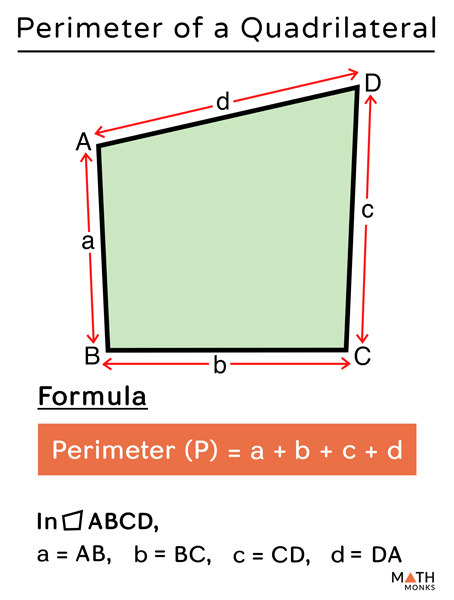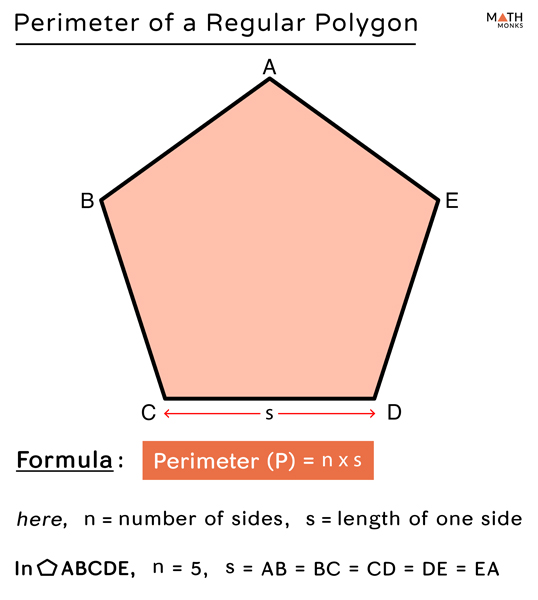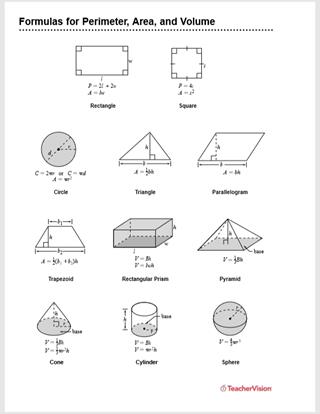Topic area and perimeter pdf: Discover the essential guide to understanding and calculating area and perimeter with our comprehensive PDF resource. This guide provides clear explanations, formulas, and practical examples to help you master these fundamental concepts. Perfect for students, teachers, and anyone looking to improve their math skills. Download now and start learning today!
Table of Content
- Understanding Area and Perimeter
- Introduction to Area and Perimeter
- Basic Concepts of Area
- Basic Concepts of Perimeter
- Formulas for Calculating Area
- Formulas for Calculating Perimeter
- Calculating Area and Perimeter of Basic Shapes
- Area and Perimeter of Rectangles
- Area and Perimeter of Squares
- Area and Perimeter of Triangles
- Area and Perimeter of Circles
- Area and Perimeter of Polygons
- Real-World Applications of Area and Perimeter
- Problem-Solving Strategies
- Common Mistakes and How to Avoid Them
- Interactive Learning Resources
- Advanced Topics in Area and Perimeter
- Conclusion and Summary
- YOUTUBE: Hướng dẫn chi tiết cách đo diện tích và chu vi trong tài liệu PDF một cách dễ dàng và nhanh chóng.
Understanding Area and Perimeter
Area and perimeter are fundamental concepts in geometry that help in understanding the dimensions of various shapes and figures. This section provides an overview, worksheets, and real-world applications of these concepts.
Area
The area of a shape is the measure of the space enclosed within its boundary. Different shapes have unique formulas for calculating area:
- Rectangle: \( \text{Area} = \text{length} \times \text{width} \)
- Triangle: \( \text{Area} = \frac{1}{2} \times \text{base} \times \text{height} \)
- Circle: \( \text{Area} = \pi r^2 \)
- Parallelogram: \( \text{Area} = \text{base} \times \text{height} \)
Perimeter
The perimeter of a shape is the total length of its boundary. The formulas for perimeter vary based on the shape:
- Rectangle: \( \text{Perimeter} = 2(\text{length} + \text{width}) \)
- Triangle: \( \text{Perimeter} = \text{side}_1 + \text{side}_2 + \text{side}_3 \)
- Circle (Circumference): \( \text{Perimeter} = 2\pi r \)
- Regular Polygon: \( \text{Perimeter} = \text{number of sides} \times \text{side length} \)
Applications in Real Life
Both area and perimeter have numerous practical applications:
- Architecture and Construction: Calculating the area and perimeter is essential for designing buildings, estimating materials, and planning spaces.
- Agriculture: Farmers use area calculations to determine the size of their fields and manage planting and harvesting.
- Urban Planning: Area and perimeter measurements help in designing parks, roads, and land plots.
- Engineering: Used in the design of various structures like bridges and roads, ensuring they meet specified dimensions and safety standards.
Downloadable Worksheets
Practice makes perfect. Here are some downloadable PDF worksheets to help reinforce the concepts of area and perimeter:
Practice Problems
Engage with interactive problems and quizzes to test your understanding of area and perimeter on platforms like .
By mastering these concepts, you can apply mathematical reasoning to everyday situations and complex professional projects alike.
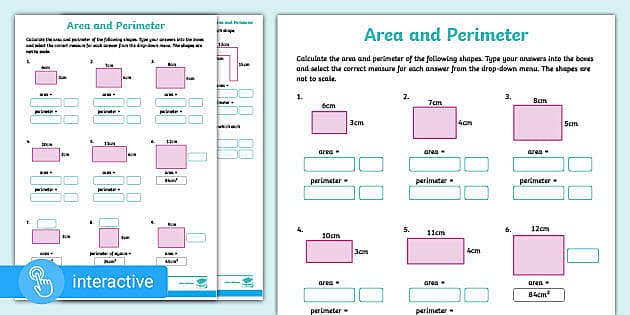
READ MORE:
Introduction to Area and Perimeter
Understanding area and perimeter is fundamental in geometry and essential for solving various real-world problems. This section introduces these concepts, providing a solid foundation for further exploration.
Area: The area is the amount of space enclosed within a shape. It is measured in square units, such as square meters (\(m^2\)) or square inches (\(in^2\)). To calculate the area of different shapes, specific formulas are used. For example:
- Rectangle: \( \text{Area} = \text{Length} \times \text{Width} \)
- Square: \( \text{Area} = \text{Side}^2 \)
- Triangle: \( \text{Area} = \frac{1}{2} \times \text{Base} \times \text{Height} \)
- Circle: \( \text{Area} = \pi \times \text{Radius}^2 \)
Perimeter: The perimeter is the total length of the boundary of a shape. It is measured in linear units, such as meters (m) or inches (in). To calculate the perimeter of different shapes, the following formulas are used:
- Rectangle: \( \text{Perimeter} = 2 \times (\text{Length} + \text{Width}) \)
- Square: \( \text{Perimeter} = 4 \times \text{Side} \)
- Triangle: \( \text{Perimeter} = \text{Side}_1 + \text{Side}_2 + \text{Side}_3 \)
- Circle: \( \text{Perimeter} = 2 \pi \times \text{Radius} \)
Mastering these concepts allows for the accurate calculation of space and boundary measurements, crucial for fields such as architecture, engineering, and everyday problem-solving.
Basic Concepts of Area
The concept of area is fundamental in geometry, representing the amount of space inside a two-dimensional shape. The area is measured in square units, such as square meters (\(m^2\)) or square inches (\(in^2\)). To grasp the basics of area, let's explore the area of various shapes step by step.
1. Area of a Rectangle:
The area of a rectangle is calculated by multiplying its length by its width:
\[ \text{Area} = \text{Length} \times \text{Width} \]
For example, if a rectangle has a length of 5 meters and a width of 3 meters, its area is:
\[ \text{Area} = 5 \, \text{m} \times 3 \, \text{m} = 15 \, \text{m}^2 \]
2. Area of a Square:
A square is a special type of rectangle where all sides are equal. The area of a square is given by:
\[ \text{Area} = \text{Side}^2 \]
For instance, if the side of a square is 4 inches, its area is:
\[ \text{Area} = 4 \, \text{in} \times 4 \, \text{in} = 16 \, \text{in}^2 \]
3. Area of a Triangle:
The area of a triangle can be found using the base and height with the following formula:
\[ \text{Area} = \frac{1}{2} \times \text{Base} \times \text{Height} \]
If a triangle has a base of 6 centimeters and a height of 4 centimeters, its area is:
\[ \text{Area} = \frac{1}{2} \times 6 \, \text{cm} \times 4 \, \text{cm} = 12 \, \text{cm}^2 \]
4. Area of a Circle:
The area of a circle is determined using the radius and the constant pi (\(\pi \approx 3.14\)):
\[ \text{Area} = \pi \times \text{Radius}^2 \]
For example, if a circle has a radius of 3 feet, its area is:
\[ \text{Area} = 3.14 \times (3 \, \text{ft})^2 = 3.14 \times 9 \, \text{ft}^2 = 28.26 \, \text{ft}^2 \]
Understanding these basic concepts and formulas enables accurate calculation of area for various shapes, forming a cornerstone for more advanced geometrical studies and practical applications.
Basic Concepts of Perimeter
The perimeter of a shape is the total length of its boundary. It is measured in linear units, such as meters (m) or inches (in). Understanding how to calculate the perimeter of various shapes is essential for solving many geometric problems. Let's explore the perimeter of different shapes step by step.
1. Perimeter of a Rectangle:
The perimeter of a rectangle is calculated by adding together the lengths of all four sides. The formula is:
\[ \text{Perimeter} = 2 \times (\text{Length} + \text{Width}) \]
For example, if a rectangle has a length of 8 meters and a width of 5 meters, its perimeter is:
\[ \text{Perimeter} = 2 \times (8 \, \text{m} + 5 \, \text{m}) = 2 \times 13 \, \text{m} = 26 \, \text{m} \]
2. Perimeter of a Square:
A square has all four sides of equal length. The perimeter of a square is given by:
\[ \text{Perimeter} = 4 \times \text{Side} \]
For instance, if the side of a square is 7 inches, its perimeter is:
\[ \text{Perimeter} = 4 \times 7 \, \text{in} = 28 \, \text{in} \]
3. Perimeter of a Triangle:
The perimeter of a triangle is the sum of the lengths of its three sides. The formula is:
\[ \text{Perimeter} = \text{Side}_1 + \text{Side}_2 + \text{Side}_3 \]
If a triangle has sides measuring 6 cm, 8 cm, and 10 cm, its perimeter is:
\[ \text{Perimeter} = 6 \, \text{cm} + 8 \, \text{cm} + 10 \, \text{cm} = 24 \, \text{cm} \]
4. Perimeter of a Circle:
The perimeter of a circle is also known as the circumference. It is calculated using the radius and the constant pi (\(\pi \approx 3.14\)). The formula is:
\[ \text{Perimeter} = 2 \pi \times \text{Radius} \]
For example, if a circle has a radius of 4 feet, its perimeter is:
\[ \text{Perimeter} = 2 \times 3.14 \times 4 \, \text{ft} = 25.12 \, \text{ft} \]
Understanding these basic concepts and formulas enables accurate calculation of the perimeter for various shapes, which is crucial for both academic and practical applications in geometry.
Formulas for Calculating Area
The area of a shape is the amount of space enclosed within its boundaries. Here are some of the most commonly used formulas for calculating the area of various shapes:
Rectangle
For a rectangle, the area is calculated by multiplying the length (\(l\)) by the width (\(w\)):
\[ \text{Area of Rectangle} = l \times w \]
Square
For a square, since all sides are equal, the area is the side length (\(s\)) squared:
\[ \text{Area of Square} = s^2 \]
Triangle
The area of a triangle is found using the base (\(b\)) and the height (\(h\)):
\[ \text{Area of Triangle} = \frac{1}{2} \times b \times h \]
Circle
The area of a circle is calculated using the radius (\(r\)) and the constant \(\pi\) (approximately 3.14159):
\[ \text{Area of Circle} = \pi \times r^2 \]
Parallelogram
The area of a parallelogram is similar to that of a rectangle, using the base (\(b\)) and the height (\(h\)):
\[ \text{Area of Parallelogram} = b \times h \]
Trapezoid
For a trapezoid, the area is found using the lengths of the two parallel sides (\(a\) and \(b\)) and the height (\(h\)):
\[ \text{Area of Trapezoid} = \frac{1}{2} \times (a + b) \times h \]
Regular Polygon
The area of a regular polygon can be calculated using the perimeter (\(P\)) and the apothem (\(a\)), which is the distance from the center to the middle of a side:
\[ \text{Area of Regular Polygon} = \frac{1}{2} \times P \times a \]
Ellipse
The area of an ellipse is calculated using the lengths of the semi-major axis (\(a\)) and the semi-minor axis (\(b\)):
\[ \text{Area of Ellipse} = \pi \times a \times b \]
| Shape | Formula |
|---|---|
| Rectangle | \( l \times w \) |
| Square | \( s^2 \) |
| Triangle | \( \frac{1}{2} \times b \times h \) |
| Circle | \( \pi \times r^2 \) |
| Parallelogram | \( b \times h \) |
| Trapezoid | \( \frac{1}{2} \times (a + b) \times h \) |
| Regular Polygon | \( \frac{1}{2} \times P \times a \) |
| Ellipse | \( \pi \times a \times b \) |
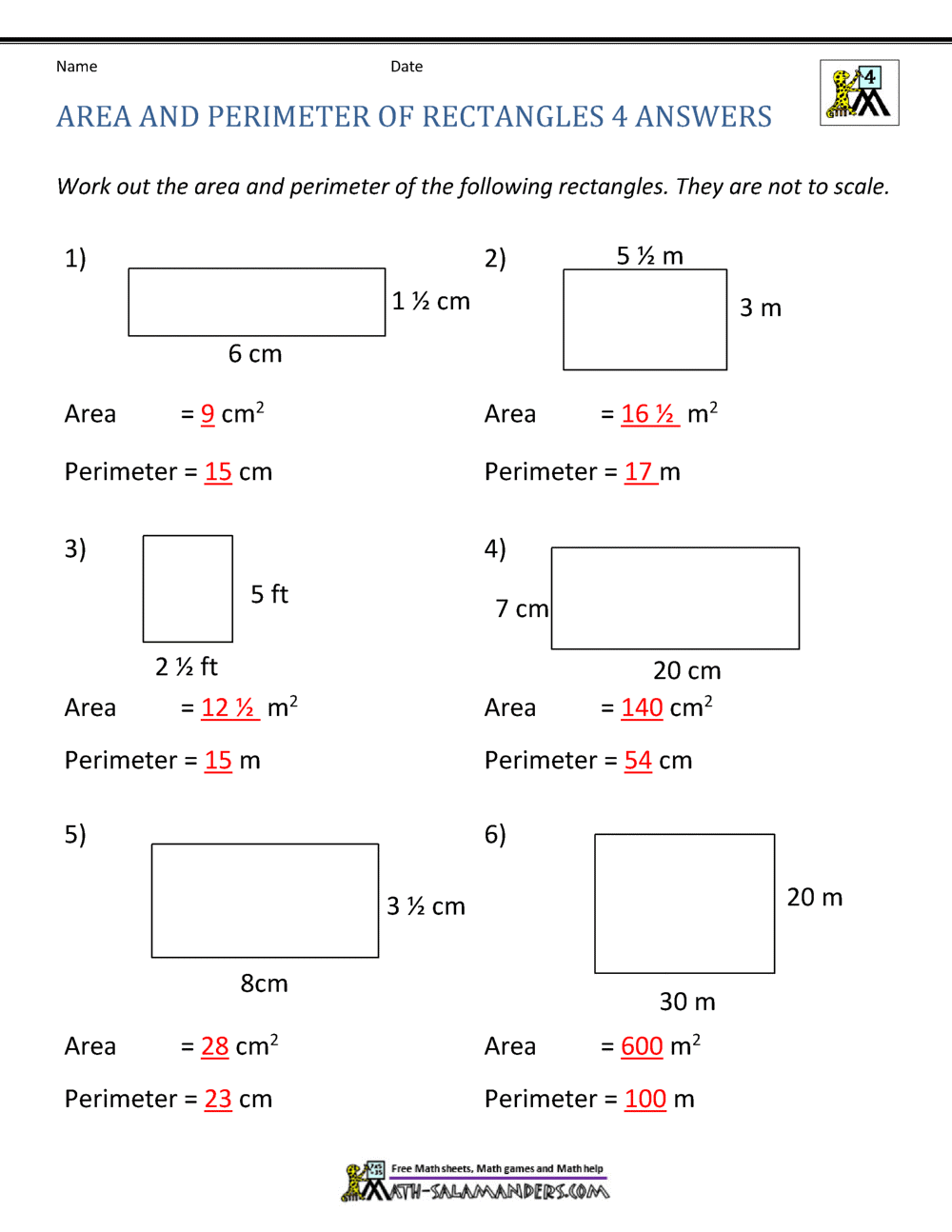
Formulas for Calculating Perimeter
The perimeter of a shape is the total length of its boundary. Here are the formulas for calculating the perimeter of various shapes:
Rectangle
The perimeter of a rectangle is calculated by adding the lengths of all four sides. Since opposite sides are equal, the formula is:
\[ \text{Perimeter of Rectangle} = 2l + 2w \]
where \( l \) is the length and \( w \) is the width.
Square
The perimeter of a square, where all four sides are of equal length, is:
\[ \text{Perimeter of Square} = 4s \]
where \( s \) is the length of a side.
Triangle
The perimeter of a triangle is the sum of the lengths of its three sides:
\[ \text{Perimeter of Triangle} = a + b + c \]
where \( a \), \( b \), and \( c \) are the lengths of the sides.
Circle (Circumference)
The perimeter of a circle is called the circumference, calculated using the radius (\( r \)) or diameter (\( d \)):
\[ \text{Circumference} = 2\pi r \] or \[ \text{Circumference} = \pi d \]
Parallelogram
The perimeter of a parallelogram is calculated by adding the lengths of its sides. Since opposite sides are equal, the formula is:
\[ \text{Perimeter of Parallelogram} = 2a + 2b \]
where \( a \) and \( b \) are the lengths of adjacent sides.
Trapezoid
The perimeter of a trapezoid is the sum of the lengths of all four sides:
\[ \text{Perimeter of Trapezoid} = a + b + c + d \]
where \( a \), \( b \), \( c \), and \( d \) are the lengths of the sides.
Regular Polygon
The perimeter of a regular polygon (a polygon with all sides and angles equal) is:
\[ \text{Perimeter of Regular Polygon} = n \times s \]
where \( n \) is the number of sides and \( s \) is the length of one side.
Irregular Polygon
The perimeter of an irregular polygon is the sum of the lengths of all its sides:
\[ \text{Perimeter of Irregular Polygon} = a_1 + a_2 + a_3 + \ldots + a_n \]
where \( a_1, a_2, \ldots, a_n \) are the lengths of the sides.
| Shape | Formula |
|---|---|
| Rectangle | \( 2l + 2w \) |
| Square | \( 4s \) |
| Triangle | \( a + b + c \) |
| Circle | \( 2\pi r \) or \( \pi d \) |
| Parallelogram | \( 2a + 2b \) |
| Trapezoid | \( a + b + c + d \) |
| Regular Polygon | \( n \times s \) |
| Irregular Polygon | \( a_1 + a_2 + a_3 + \ldots + a_n \) |
Calculating Area and Perimeter of Basic Shapes
Understanding how to calculate the area and perimeter of basic shapes is fundamental in geometry. Below, we will discuss the formulas for calculating the area and perimeter of various basic shapes.
Rectangle
- Area: \(A = l \times w\) where \(l\) is the length and \(w\) is the width.
- Perimeter: \(P = 2(l + w)\).
Square
- Area: \(A = s^2\) where \(s\) is the length of a side.
- Perimeter: \(P = 4s\).
Triangle
- Area: \(A = \frac{1}{2} \times b \times h\) where \(b\) is the base and \(h\) is the height.
- Perimeter: \(P = a + b + c\) where \(a\), \(b\), and \(c\) are the lengths of the sides.
Circle
- Area: \(A = \pi r^2\) where \(r\) is the radius.
- Perimeter (Circumference): \(P = 2\pi r\).
Regular Polygon
- Area: \(A = \frac{1}{4} n s^2 \cot(\pi/n)\) where \(n\) is the number of sides and \(s\) is the length of a side.
- Perimeter: \(P = n \times s\).
These formulas are essential for solving various problems involving basic geometric shapes. Understanding and applying these formulas allows us to measure spaces and boundaries accurately, which is crucial in fields like architecture, engineering, and everyday tasks.
Area and Perimeter of Rectangles
Understanding the area and perimeter of rectangles is fundamental in geometry. Below are the formulas and step-by-step methods to calculate both the area and perimeter of a rectangle.
Perimeter of a Rectangle
The perimeter of a rectangle is the total distance around the edge of the rectangle. It can be calculated using the formula:
\[
\text{Perimeter} = 2 \times (\text{length} + \text{width})
\]
Where:
- Length (l) is the longer side of the rectangle.
- Width (w) is the shorter side of the rectangle.
Steps to calculate the perimeter:
- Measure the length and width of the rectangle.
- Add the length and the width together.
- Multiply the sum by 2.
Example:
If a rectangle has a length of 8 meters and a width of 3 meters, the perimeter would be calculated as follows:
\[
\text{Perimeter} = 2 \times (8 + 3) = 2 \times 11 = 22 \text{ meters}
\]
Area of a Rectangle
The area of a rectangle is the amount of space inside the rectangle. It can be calculated using the formula:
\[
\text{Area} = \text{length} \times \text{width}
\]
Where:
- Length (l) is the longer side of the rectangle.
- Width (w) is the shorter side of the rectangle.
Steps to calculate the area:
- Measure the length and width of the rectangle.
- Multiply the length by the width.
Example:
If a rectangle has a length of 8 meters and a width of 3 meters, the area would be calculated as follows:
\[
\text{Area} = 8 \times 3 = 24 \text{ square meters}
\]
Summary Table
| Shape | Formula for Perimeter | Formula for Area |
|---|---|---|
| Rectangle | \(2 \times (l + w)\) | \(l \times w\) |
Area and Perimeter of Squares
The square is a special type of rectangle where all four sides are equal in length. Both the area and the perimeter of a square can be calculated easily using the length of one of its sides.
Perimeter of a Square
The perimeter of a square is the total length around the square. Since all sides of a square are equal, the perimeter (P) can be calculated using the formula:
Formula:
\[
P = 4s
\]
Where \( s \) is the length of one side of the square.
Area of a Square
The area of a square is the amount of space enclosed within its sides. It is calculated by squaring the length of one side:
Formula:
\[
A = s^2
\]
Where \( s \) is the length of one side of the square.
Example Calculation
Consider a square with each side of length 5 units:
- Perimeter:
\[
P = 4 \times 5 = 20 \text{ units}
\] - Area:
\[
A = 5^2 = 25 \text{ square units}
\]
Using these formulas, you can easily find the area and perimeter of any square by substituting the length of its side into the appropriate formula.

Area and Perimeter of Triangles
Triangles are fundamental shapes in geometry, and calculating their area and perimeter is crucial for various applications. Below, we detail the formulas and steps for finding the area and perimeter of different types of triangles.
Types of Triangles
- Equilateral Triangle
- Isosceles Triangle
- Scalene Triangle
Formulas
Perimeter of a Triangle
The perimeter of a triangle is the sum of the lengths of its three sides.
For a triangle with sides \(a\), \(b\), and \(c\):
\[
\text{Perimeter} = a + b + c
\]
Area of a Triangle
The area of a triangle can be calculated using different formulas depending on the type of triangle and the given information.
Using Base and Height
The most common formula involves the base and height of the triangle:
\[
\text{Area} = \frac{1}{2} \times \text{base} \times \text{height}
\]
Where the base is one side of the triangle, and the height is the perpendicular distance from the base to the opposite vertex.
Using Heron's Formula
Heron's formula is useful when all three sides of the triangle are known:
First, calculate the semi-perimeter \(s\):
\[
s = \frac{a + b + c}{2}
\]
Then, use the semi-perimeter to find the area:
\[
\text{Area} = \sqrt{s(s - a)(s - b)(s - c)}
\]
Example Calculations
Example 1: Equilateral Triangle
Given an equilateral triangle with each side \(a = 6\) units:
- Perimeter: \(6 + 6 + 6 = 18\) units
- Area: \[ \text{Area} = \frac{\sqrt{3}}{4} \times a^2 = \frac{\sqrt{3}}{4} \times 6^2 = \frac{\sqrt{3}}{4} \times 36 = 9\sqrt{3} \approx 15.59 \text{ square units} \]
Example 2: Right Triangle
Given a right triangle with base \(b = 3\) units and height \(h = 4\) units:
- Perimeter: \(3 + 4 + 5 = 12\) units (using Pythagorean theorem to find hypotenuse \(c = 5\) units)
- Area: \[ \text{Area} = \frac{1}{2} \times 3 \times 4 = 6 \text{ square units} \]
Example 3: Scalene Triangle
Given a scalene triangle with sides \(a = 5\) units, \(b = 6\) units, and \(c = 7\) units:
- Perimeter: \(5 + 6 + 7 = 18\) units
- Area using Heron's formula: \[ s = \frac{5 + 6 + 7}{2} = 9 \] \[ \text{Area} = \sqrt{9(9 - 5)(9 - 6)(9 - 7)} = \sqrt{9 \times 4 \times 3 \times 2} = \sqrt{216} \approx 14.7 \text{ square units} \]
By understanding and applying these formulas, you can accurately determine the area and perimeter of any triangle.
Area and Perimeter of Circles
Understanding the area and perimeter (circumference) of circles is essential for solving many real-world problems. Below, we provide the formulas and a detailed explanation of each component.
Perimeter (Circumference) of a Circle
The circumference of a circle is the distance around the circle. It can be calculated using the radius (r) or the diameter (d) of the circle.
- Formula using the radius: \( C = 2\pi r \)
- Formula using the diameter: \( C = \pi d \)
Where:
- \( \pi \) (Pi) is approximately 3.14159
- r is the radius of the circle
- d is the diameter of the circle (d = 2r)
Area of a Circle
The area of a circle is the amount of space enclosed within its boundary. It can also be calculated using the radius or the diameter.
- Formula using the radius: \( A = \pi r^2 \)
- Formula using the diameter: \( A = \frac{\pi d^2}{4} \)
Where:
- \( \pi \) (Pi) is approximately 3.14159
- r is the radius of the circle
- d is the diameter of the circle (d = 2r)
Step-by-Step Example
Let's consider a circle with a radius of 5 units. We'll calculate both the circumference and the area.
- Circumference:
- Using the formula \( C = 2\pi r \)
- Substitute \( r = 5 \): \( C = 2 \times 3.14159 \times 5 \)
- Calculate: \( C \approx 31.4159 \) units
- Area:
- Using the formula \( A = \pi r^2 \)
- Substitute \( r = 5 \): \( A = 3.14159 \times 5^2 \)
- Calculate: \( A \approx 78.53975 \) square units
Practical Applications
Understanding the area and circumference of circles can be applied in various real-world contexts, such as:
- Calculating the length of a fence needed to enclose a circular garden.
- Determining the amount of material required to cover a circular surface, like a tablecloth or a circular rug.
- Estimating the distance one would travel if walking around a circular park.
Area and Perimeter of Polygons
Polygons are shapes with multiple straight sides. Here, we will explore how to calculate the area and perimeter of various polygons.
Regular Polygons
A regular polygon has all sides and angles equal.
- Perimeter: The perimeter \(P\) of a regular polygon with \(n\) sides, each of length \(s\), is calculated as: \[ P = n \times s \]
- Area: The area \(A\) of a regular polygon can be calculated using the formula: \[ A = \frac{1}{4} n s^2 \cot \left( \frac{\pi}{n} \right) \]
Irregular Polygons
Irregular polygons have sides and angles of different lengths and measures.
- Perimeter: The perimeter is found by summing the lengths of all sides: \[ P = \sum_{i=1}^{n} s_i \]
- Area: The area can be calculated using the coordinates of the vertices or by dividing the polygon into simpler shapes like triangles and rectangles. For example, using the Shoelace formula for vertices \((x_1, y_1), (x_2, y_2), ..., (x_n, y_n)\): \[ A = \frac{1}{2} \left| \sum_{i=1}^{n-1} (x_i y_{i+1} - x_{i+1} y_i) + (x_n y_1 - x_1 y_n) \right| \]
Example: Regular Hexagon
- Perimeter: For a hexagon with side length \(s\): \[ P = 6 \times s \]
- Area: Using the formula for regular polygons: \[ A = \frac{3\sqrt{3}}{2} s^2 \]
Example: Irregular Quadrilateral
- Perimeter: Sum of all sides \(s_1, s_2, s_3, s_4\): \[ P = s_1 + s_2 + s_3 + s_4 \]
- Area: Divide into two triangles and use the area formula for triangles: \[ A = \text{Area of } \triangle 1 + \text{Area of } \triangle 2 \]
Real-World Applications of Area and Perimeter
The concepts of area and perimeter are essential in various real-world scenarios. Understanding these measurements can help in numerous practical applications:
- Architecture and Construction:
Architects and builders use area and perimeter calculations to determine the amount of materials needed, the layout of structures, and to ensure efficient use of space.
- For instance, calculating the perimeter of a plot of land helps in planning the fencing, while the area helps in determining the foundation and floor space.
- Interior Design:
Interior designers use these measurements to plan the arrangement of furniture and décor. Knowing the area of a room helps in selecting the right size of carpets, while the perimeter is useful for installing moldings and trims.
- Agriculture:
Farmers use area calculations to determine the size of their fields, which is crucial for planning crop rotation, irrigation, and the application of fertilizers and pesticides.
- For example, calculating the area of a field helps in estimating the yield and planning the distribution of crops.
- Urban Planning:
Urban planners use area and perimeter to design parks, roads, and other public infrastructure. Accurate measurements ensure efficient land use and proper planning of amenities.
- Sports:
In sports, the area and perimeter of fields, courts, and tracks are critical for ensuring standardized dimensions and fair play. For instance, the area of a basketball court determines the playing surface, while the perimeter helps in setting up boundaries and fencing.
- Environmental Science:
Environmentalists use these calculations to study habitats, manage natural resources, and plan conservation efforts. The area of a forest can be used to estimate biomass, while the perimeter is important for studying edge effects and habitat fragmentation.
By mastering the calculations of area and perimeter, individuals and professionals can make informed decisions, optimize resources, and effectively manage various projects in their respective fields.
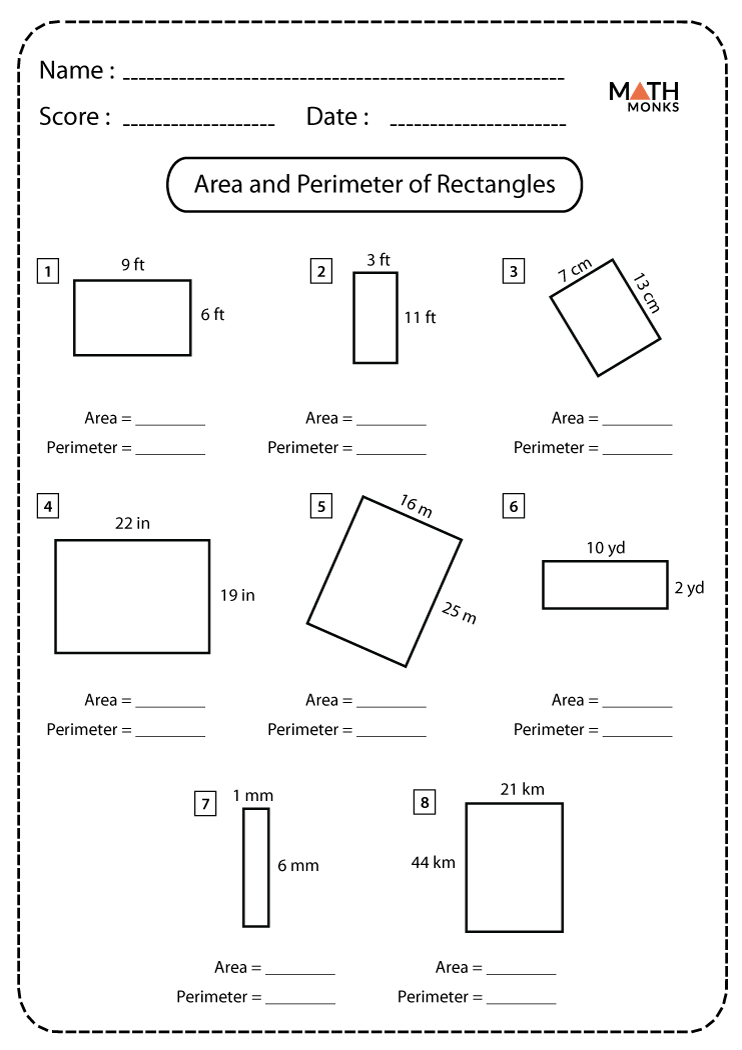
Problem-Solving Strategies
Effective problem-solving strategies for area and perimeter involve a series of logical steps and practical approaches. Here are detailed strategies to help tackle problems related to these mathematical concepts:
1. Understand the Problem
- Read the Problem Carefully: Identify what is being asked and what information is provided.
- Identify Shapes Involved: Determine the shapes in question (e.g., rectangles, triangles, circles).
- Visualize the Problem: Draw diagrams if necessary to better understand the problem.
2. Gather Relevant Formulas
- Area Formulas:
- Rectangle: \( \text{Area} = l \times w \)
- Triangle: \( \text{Area} = \frac{1}{2} \times \text{base} \times \text{height} \)
- Circle: \( \text{Area} = \pi r^2 \)
- Polygon: Break it into simpler shapes or use specific polygon formulas.
- Perimeter Formulas:
- Rectangle: \( \text{Perimeter} = 2(l + w) \)
- Triangle: \( \text{Perimeter} = a + b + c \)
- Circle: \( \text{Perimeter} = 2\pi r \) (Circumference)
- Polygon: Sum of all sides.
3. Solve Step-by-Step
- Break Down the Problem: Divide the problem into manageable parts.
- Apply Formulas: Use the gathered formulas to calculate area and perimeter.
- Perform Calculations: Ensure accuracy in your calculations by double-checking each step.
4. Check Your Work
- Review Calculations: Verify each step to ensure no errors were made.
- Cross-Verify with Different Methods: If possible, solve the problem using an alternative method to confirm results.
5. Practical Applications
- Real-World Context: Relate problems to real-world scenarios to understand their practical relevance, such as determining the amount of paint needed for a wall or the fencing required for a garden.
Example Problem
Problem: Find the area and perimeter of a rectangle with a length of 10 units and a width of 5 units.
- Understand the Problem: We need to calculate both the area and perimeter of the rectangle.
- Gather Formulas:
- Area of Rectangle: \( \text{Area} = l \times w \)
- Perimeter of Rectangle: \( \text{Perimeter} = 2(l + w) \)
- Solve Step-by-Step:
- Calculate Area: \( \text{Area} = 10 \times 5 = 50 \, \text{units}^2 \)
- Calculate Perimeter: \( \text{Perimeter} = 2(10 + 5) = 2 \times 15 = 30 \, \text{units} \)
- Check Your Work: Verify the calculations to ensure correctness.
By following these strategies, you can systematically approach and solve problems related to area and perimeter effectively.
Common Mistakes and How to Avoid Them
Understanding area and perimeter concepts can sometimes be tricky, but avoiding common mistakes can help improve your accuracy. Here are some pitfalls to watch out for:
-
Forgetting units: Always remember to include units in your answers. Whether it's square units for area or linear units for perimeter, units are essential for clear communication.
-
Misinterpreting dimensions: Double-check the given dimensions of shapes before applying formulas. Incorrect measurements can lead to inaccurate results.
-
Confusing formulas: Be sure to use the correct formulas for calculating area and perimeter of different shapes. Mixing up formulas can result in incorrect solutions.
-
Ignoring precision: Pay attention to precision in your calculations, especially when dealing with real-world applications. Rounding errors can affect the accuracy of your solutions.
-
Skipping visualization: Take the time to visualize shapes and their properties. A clear understanding of the geometry involved can help you avoid errors in calculations.
Interactive Learning Resources
Interactive learning resources can greatly enhance understanding and retention of concepts related to area and perimeter. Below are some recommended resources and activities to help you master these topics:
-
Online Quizzes and Games:
Engage with online quizzes and games that provide instant feedback on your understanding of area and perimeter concepts.
-
Interactive Tutorials:
Step-by-step tutorials with interactive elements help to visualize and practice calculating area and perimeter.
-
Math Apps:
Utilize mobile apps that offer interactive exercises and problem-solving activities.
- - An app for creating and exploring geometric shapes and their properties.
- - A collection of games to practice various math skills, including area and perimeter.
-
Printable Worksheets:
Download and print worksheets for hands-on practice.
-
Interactive Math Software:
Explore software designed to teach and reinforce mathematical concepts through interactive activities.
Additionally, here is a simple table summarizing some of the best resources:
| Resource Type | Resource Name | Link |
|---|---|---|
| Online Games | Math Playground | |
| Interactive Tutorials | Khan Academy | |
| Math Apps | Geometry Pad | |
| Worksheets | Math-Drills | |
| Math Software | GeoGebra |
Using these resources, students can deepen their understanding of area and perimeter through engaging and interactive activities.
Advanced Topics in Area and Perimeter
In this section, we will delve into more complex concepts related to area and perimeter, including the study of irregular shapes, the use of calculus in finding areas, and the application of advanced geometric principles.
1. Area and Perimeter of Irregular Shapes
Calculating the area and perimeter of irregular shapes often involves dividing the shape into regular polygons, calculating each part separately, and then summing the results.
- Decomposition Method: Divide the irregular shape into known polygons (e.g., triangles, rectangles).
- Summation: Add the areas of each part to get the total area.
- Boundary Lengths: Sum the perimeters of each part, adjusting for shared boundaries.
2. Calculus for Area Calculation
Calculus can be used to find the area under curves, which is particularly useful for irregular shapes.
- Definite Integrals: Use definite integrals to calculate the area under a curve \(y = f(x)\) from \(x = a\) to \(x = b\).
- Formula: \(\int_{a}^{b} f(x) \, dx\)
- Example: For \(f(x) = x^2\) from \(x = 0\) to \(x = 1\), the area is \(\int_{0}^{1} x^2 \, dx = \left[ \frac{x^3}{3} \right]_{0}^{1} = \frac{1}{3}\).
3. Application of Advanced Geometric Principles
Advanced geometry involves the study of complex shapes and the relationships between their sides, angles, and dimensions.
- Coordinate Geometry: Use coordinates to calculate lengths and areas.
- Example: Distance formula between points \((x_1, y_1)\) and \((x_2, y_2)\): \(d = \sqrt{(x_2 - x_1)^2 + (y_2 - y_1)^2}\).
- Heron's Formula: For a triangle with sides \(a\), \(b\), and \(c\): \(A = \sqrt{s(s-a)(s-b)(s-c)}\), where \(s = \frac{a+b+c}{2}\).
4. Volume and Surface Area
Extending the concept of area and perimeter to three dimensions leads to the study of volume and surface area.
- Volume of Solids: Formulas for different shapes (e.g., cube, sphere, cylinder).
- Surface Area: Sum of the areas of all faces of a 3D object.
- Example: Volume of a sphere: \(V = \frac{4}{3} \pi r^3\), Surface area: \(A = 4 \pi r^2\).
5. Real-World Applications
Understanding advanced area and perimeter concepts is essential in fields such as architecture, engineering, and computer graphics.
- Architecture: Designing complex structures and calculating materials required.
- Engineering: Optimizing space and materials in manufacturing.
- Computer Graphics: Rendering shapes and calculating pixel areas.
By mastering these advanced topics, you will gain a deeper understanding of the mathematical principles underlying area and perimeter, and be able to apply these concepts to solve complex real-world problems.
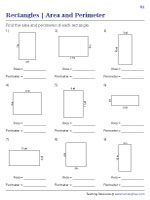
Conclusion and Summary
Understanding the concepts of area and perimeter is fundamental in mathematics, with applications in various fields ranging from geometry to real-life problem solving. This guide has provided a comprehensive overview, from basic definitions to advanced topics. Here, we summarize the key points:
- Basic Concepts: Area is the measure of the space inside a shape, while perimeter is the distance around a shape.
- Formulas: Various shapes have specific formulas to calculate their area and perimeter. For instance, the area of a rectangle is \( \text{length} \times \text{width} \), and its perimeter is \( 2 \times (\text{length} + \text{width}) \).
- Applications: These concepts are used in fields such as architecture, engineering, and even everyday activities like gardening or home decorating.
- Advanced Topics: We explored complex shapes, transformations, and the application of calculus in finding areas under curves, demonstrating the depth and versatility of these mathematical concepts.
By mastering the calculations of area and perimeter, you can solve practical problems more efficiently and gain a deeper appreciation of geometric properties. Continue practicing with different shapes and real-world problems to enhance your skills further.
For interactive learning resources, including quizzes and practice problems, visit educational platforms such as and . These resources offer detailed explanations and practice questions to reinforce your understanding.
We hope this guide has been helpful in your journey to mastering area and perimeter. Keep exploring and practicing to continue building your mathematical prowess.
Hướng dẫn chi tiết cách đo diện tích và chu vi trong tài liệu PDF một cách dễ dàng và nhanh chóng.
Cách đo diện tích và chu vi trong tài liệu PDF
READ MORE:
Hướng dẫn chi tiết cách tính diện tích và chu vi trong tệp PDF một cách dễ dàng và chính xác.
Cách tính diện tích và chu vi với tệp PDF








